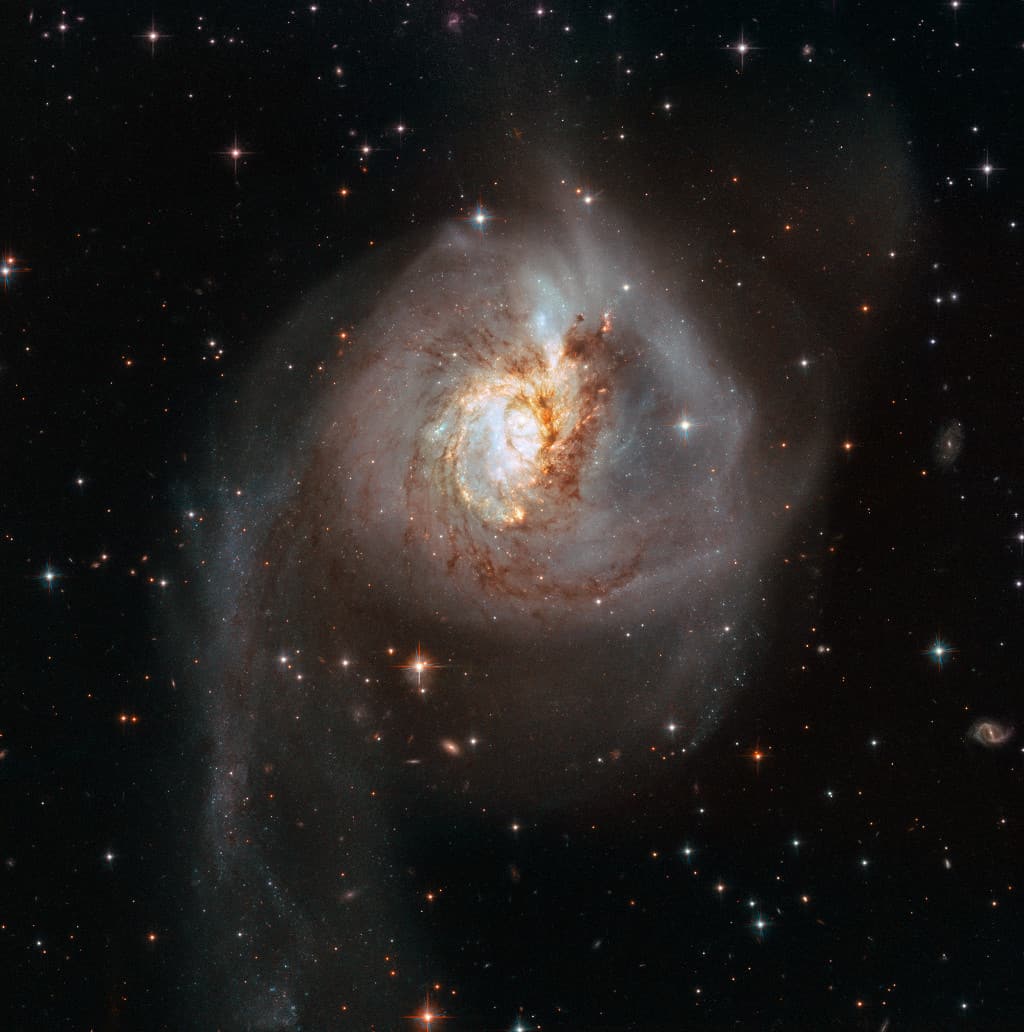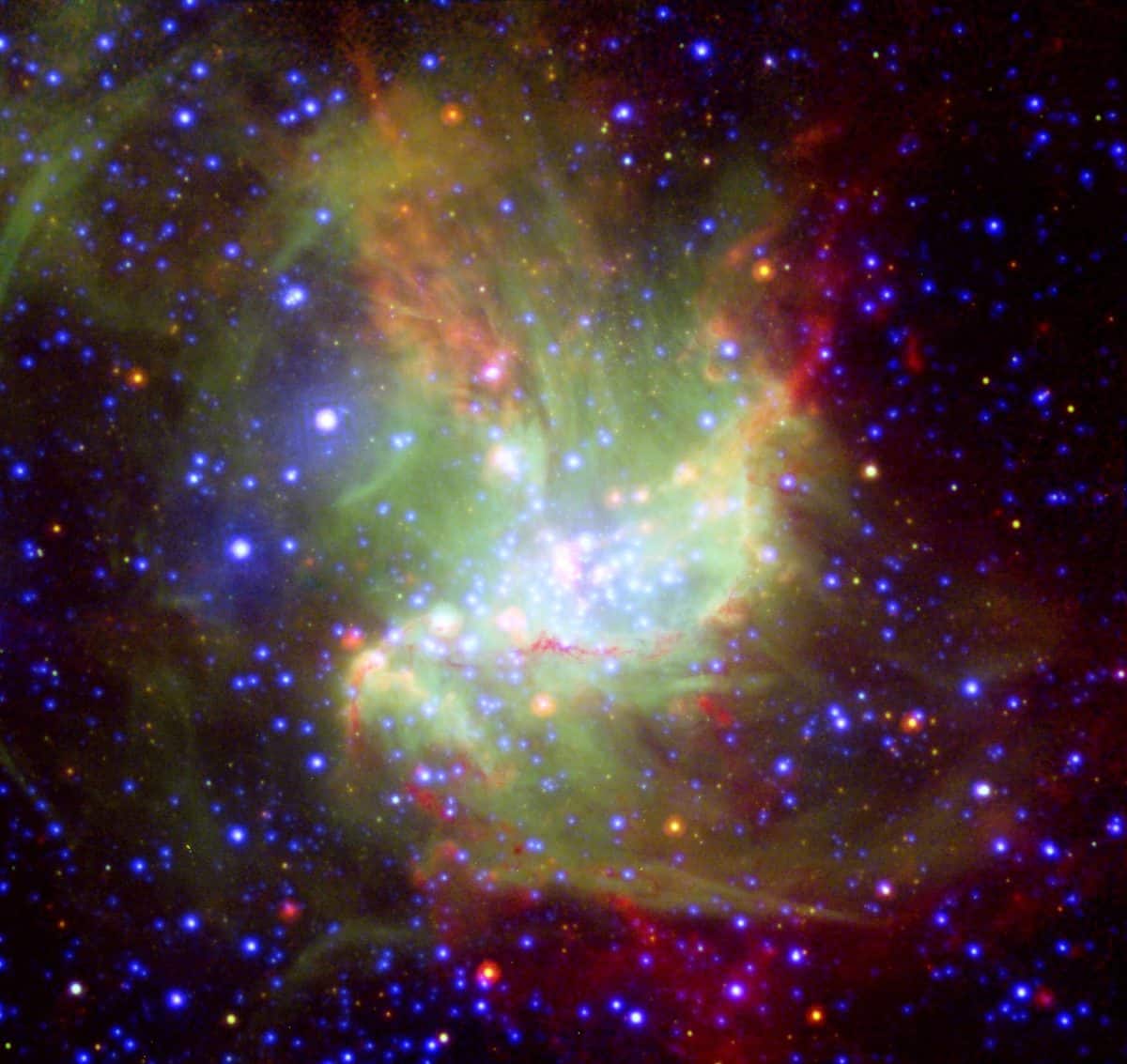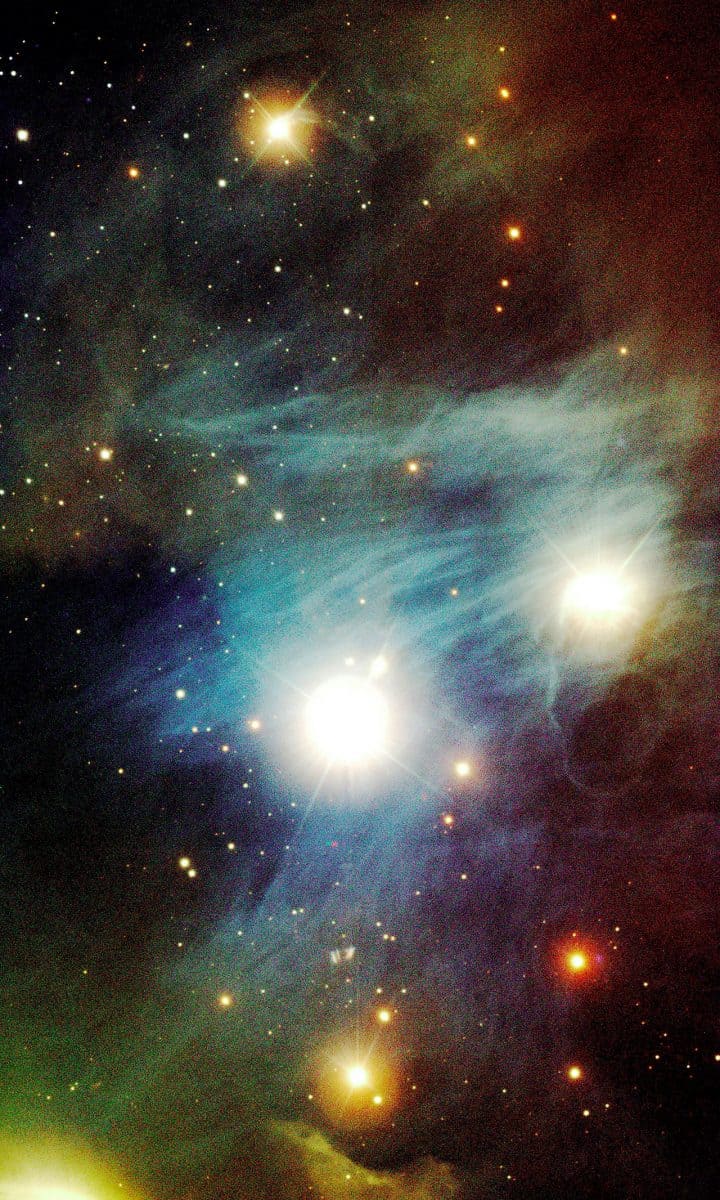This new portrait of the bright star-forming region NGC 346, in which different wavelengths of light swirl together like watercolours, reveals new information about how stars form. NGC 346 is located 210,000 light-years away in the Small Magellanic Cloud, a neighbouring dwarf galaxy of the Milky Way. The image is based on data from ESA XMM-Newton (X-rays; blue), ESO’s New Technology Telescope (visible light; green), and NASA’s Spitzer (infrared; red). The infrared light shows cold dust, while the visible light denotes glowing gas, and the X-rays represent very hot gas. Ordinary stars appear as blue spots with white centres, while young stars enshrouded in dust appear as red spots with white centres.
see full post...William Royce “Boz” Scaggs (born June 8, 1944) is an American singer, songwriter, and guitarist. He was a guitarist and occasional lead singer with the Steve Miller Band in the 1960s, and in the 1970s gained fame with several solo Top 20 hit singles in the United States, including the hits “Lido Shuffle” and “Lowdown” from the critically acclaimed album Silk Degrees (1976), which peaked at #2 on the Billboard 200. Scaggs continues to write, record music, and tour.
Scaggs was born in Canton, Ohio, the eldest child of a traveling salesman. Their family moved to McAlester, Oklahoma, then to Plano, Texas (at that time a farm town), just north of Dallas. He attended a Dallas private school, St. Mark’s School of Texas, where schoolmate Mal Buckner gave him the nickname “Bosley”, later shortened to “Boz”
see full post...William Russell Watrous III (born June 8, 1939) is a jazz trombonist. He is perhaps best known by casual fans of jazz music for his rendition of Sammy Nestico‘s arrangement of the Johnny Mandel ballad “A Time for Love,” which he recorded on a 1993 album of the same name. A self-described “bop-oriented” player, he is well known among fellow trombonists as a master technician and for his mellifluous sound.
Watrous’ father, also a trombonist, introduced him to the instrument at an early age. While serving in the U.S. Navy, Watrous studied with jazz pianist and composer Herbie Nichols. His first professional performances were in Billy Butterfield‘s band.
see full post...Wilhelmina Goodson, known professionally as Billie Pierce (June 8, 1907 – September 29, 1974), was an American jazz pianist and singer.
Wilhelmina (Billie) Goodson was born on June 8, 1907 in her mother’s hometown of Marianna, Florida, United States, and grew up in Pensacola, Florida. She was one of six piano-playing sisters (including Ida Goodson and Sadie Goodson) whose mother and father (Madison H. Goodson and Sarah Jenkins Goodson) also played the piano.[2] There was a seventh daughter, Maggie, who died young. Billie was the second youngest of the girls; the order of the sisters from oldest to youngest went Mabel (b. 1899), Della (1901), Sadie (1903), Edna (1904), Billie (1907), and Ida (1909).
Goodson was never formally trained to read music. Both of her parents musicians, they played hymns and sang in the choir at the Baptist church where Madison Goodson was a Deacon. According to Billie, she was about two years old when she first started to play the piano.
Though her parents disapproved of ragtime, blues, and jazz, only playing religious music, Billie and her sisters were drawn to it. When Ms. Pierce was about ten years old, she and her sisters would go down to the Belmont Theater to listen to Ma Rainey, Ida Cox, and Bessie Smith when they passed through Pensacola, Florida. In 1922, when Ms. Pierce was almost thirteen, Bessie Smith passed through town again. Bessie’s pianist, Clarence Williams, suffered a heart attack and Ms. Pierce subbed in to played piano with Bessie Smith for two weeks at the Belmont Theater.
see full post...World Music on Flamenco Fridays
see full post...Marked by an unusually bright central region, swirling dust lanes, and far flung tidal tails, peculiar NGC 3256 is the aftermath of a truly cosmic collision. The 500 million year old clash of two separate galaxies spans some 100 thousand light-years in this sharp Hubble view. Of course when two galaxies collide, individual stars rarely do. Giant galactic clouds of molecular gas and dust do interact though, and produce spectacular bursts of star formation. In this galaxy clash, the two original spiral galaxies had similar masses. Their disks are no longer distinct and the two galactic nuclei are hidden by obscuring dust. On the timescale of a few hundred million years the nuclei will likely also merge as NGC 3256 becomes a single large elliptical galaxy. NGC 3256 itself is nearly 100 million light-years distant toward the southern sailing constellation Vela. The frame includes many even more distant background galaxies and spiky foreground stars.

This image, taken with the Wide Field Camera 3 (WFC3) and the Advanced Camera for Surveys (ACS), both installed on the NASA/ESA Hubble Space Telescope, shows the peculiar galaxy NGC 3256. The galaxy is about 100 million light-years from Earth and is the result of a past galactic merger, which created its distorted appearance. As such, NGC 3256 provides an ideal target to investigate starbursts that have been triggered by galaxy mergers. Another image of NGC 3256 was already released in 2008, as part of a collection of interacting galaxies, created for Hubble’s 18th birthday.
Harold Floyd “Tina” Brooks (June 7, 1932 – August 13, 1974) was an American hard bop, blues, and funk tenor saxophonist and composer.
Harold Floyd Brooks was born in Fayetteville, North Carolina, and was the brother of David “Bubba” Brooks. The nickname “Tina”, pronounced Teena, was a variation of “Teeny”, a childhood moniker. His favourite tune was “My Devotion”. He studied harmony and theory with Herbert Bourne.
Initially, he studied the C-melody saxophone, which he began playing shortly after he moved to New York with his family in 1944. Brooks’ first professional work came in 1951 with rhythm and blues pianist Sonny Thompson, and in 1955 Brooks played with vibraphonist Lionel Hampton. Brooks also received less formal guidance from trumpeter and composer “Little” Benny Harris, who led the saxophonist to his first recording as a leader. Harris, in fact, was the one who recommended him to Blue Note Records producer Alfred Lion in 1958.
see full post...Talmage Holt Farlow (June 7, 1921 – July 25, 1998) was an American jazz guitarist. He was nicknamed “Octopus” because of how his large, quick hands spread over the fretboard. As Steve Rochinski notes, “Of all the guitarists to emerge in the first generation after Charlie Christian, Tal Farlow, more than any other, has been able to move beyond the rhythmic, melodic, and harmonic vocabulary associated with the early electric guitar master. Tal’s incredible speed, long, weaving lines, rhythmic excitement, highly developed harmonic sense, and enormous reach (both physical and musical) have enabled him to create a style that clearly stands apart from the rest.” Where guitarists of his day combined rhythmic chords with linear melodies, Farlow placed single notes together in clusters, varying between harmonically enriched tones. As music critic Stuart Nicholson put it, “In terms of guitar prowess it was the equivalent of Roger Bannister breaking the four minute mile.”
Talmage Holt Farlow was born in Greensboro, in 1921. He taught himself how to play guitar, which he started when he was twenty-two years old. He learned chord melodies by playing a mandolin tuned like a ukulele. He said playing the ukulele was the reason he used the higher four strings on the guitar for the melody and chord structure, with the two bottom strings for bass counterpoint, which he played with his thumb. His only professional training was as an apprentice sign painter. He requested the night shift so he could listen to big band standards on the shop radio. He listened to Bix Beiderbecke, Louis Armstrong, and Eddie Lang. His career was influenced by hearing Charlie Christian playing electric guitar with the Benny Goodman band. He said he made his own electric guitar because he couldn’t afford one.
Farlow employed artificial harmonics and tapped his guitar for percussion, creating a flat, snare drum sound or a hollow backbeat like the bongos.His large, quick hands earned him the nickname “The Octopus”.
see full post...Frederic Galliano was born December 23, 1969 in Grenoble. He’s an eclectic musician who works with cutting edge electronic music, jazz and world music.
see full post...This colour-composite image was obtained by FORS1 on ANTU. It displays a sky area near the Chamaeleon I complex of bright nebulae and hot stars in the constellation of the same name, close to the southern celestial pole.This picture was taken a few days before the Paranal Inauguration and the “hand-over” to the astronomers on April 1, 1999.This colour composite photo of the Chamaeleon I area is based on six 1-min exposures obtained with VLT UT1 + FORS1 in the V, R and I bands. The sky field measures 6.8 x 11.2 arcmin2; North is up and East is left.
A photogenic group of nebulae can be found in Chamaeleon, a constellation visible predominantly in skies south of the Earth’s equator. Towards Chamaeleon, dark molecular clouds and bright planetary nebula NGC 3195 can be found. Visible near the center of the above photograph is a reflection nebula surrounding a young bright star. On the lower right, a dark molecular cloud blocks the light from stars behind it. It takes light hundreds of years to reach us from these objects.
In 1999, a nearby open cluster was discovered centered on the star η Chamaeleontis. The cluster, known as either the Eta Chamaeleontis cluster or Mamajek 1, is 8 million years old, and lies 316 light years from Earth.
The constellation contains a number of molecular clouds (the Chamaeleon dark clouds) that are forming low-mass T Tauri stars. The cloud complex lies some 400 to 600 light years from Earth, and contains tens of thousands of solar masses of gas and dust. The most prominent cluster of T Tauri stars and young B-type stars are in the Chamaeleon I cloud, and are associated with the reflection nebula IC 2631.
Chamaeleon contains one planetary nebula, NGC 3195, which is fairly faint. It appears in a telescope at about the same apparent size as Jupiter.
see full post...Montgomery Bernard “Monty” Alexander (born 6 June 1944) is a jazz pianist. His playing has a Caribbean influence and bright swinging feeling, with a strong vocabulary of bebop jazz and blues rooted melodies.He was influenced by Louis Armstrong, Duke Ellington, Nat King Cole, Oscar Peterson, and Frank Sinatra. Alexander also sings and plays the melodica. He is known for his surprising musical twists, bright rhythmic sense, and intense dramatic musical climaxes. Monty’s recording career has covered many of the well known American songbook standards, jazz standards, pop hits, and Jamaican songs from his original homeland. Alexander has resided in New York City for many years and performs frequently throughout the world at jazz festivals and clubs.
Alexander was born on 6 June 1944 in Kingston, Jamaica. He discovered the piano when he was four years old and seemed to have a knack for picking melodies out by ear. His mother sent him to classical music lessons at the age of six and became interested in jazz piano at the age of 14, and began playing in clubs, and on recording sessions by Clue J & His Blues Blasters, subbing for Aubrey Adams, whom he describes as his hero, when he was unable to play. Two years later, he directed a dance orchestra (Monty and the Cyclones) and played in the local clubs covering much of the 1960s early rock and pop dance hits. Performances at the Carib Theater in Jamaica by Louis Armstrong and Nat King Cole left a strong impression on the young pianist.
see full post...Grant Green (June 6, 1935 – January 31, 1979) was an American jazz guitarist and composer.
Recording prolifically and mainly for Blue Note Records as both leader and sideman, Green performed in the hard bop, soul jazz, bebop, and Latin-tinged idioms throughout his career. Critics Michael Erlewine and Ron Wynn write, “A severely underrated player during his lifetime, Grant Green is one of the great unsung heroes of jazz guitar … Green’s playing is immediately recognizable – perhaps more than any other guitarist.” Critic Dave Hunter described his sound as “lithe, loose, slightly bluesy and righteously groovy”. He often performed in an organ trio, a small group with an organ and drummer.
Apart from guitarist Charlie Christian, Green’s primary influences were saxophonists, particularly Charlie Parker, and his approach was therefore almost exclusively linear rather than chordal. He thus rarely played rhythm guitar except as a sideman on albums led by other musicians. The simplicity and immediacy of Green’s playing, which tended to avoid chromaticism, derived from his early work playing rhythm and blues and, although at his best he achieved a synthesis of this style with bop, he was essentially a blues guitarist and returned almost exclusively to this style in his later career.
Green was born in St. Louis, Missouri. He first performed in a professional setting at the age of 13 as a member of a gospel music ensemble. His influences were Charlie Christian, Charlie Parker, Lester Young, and Jimmy Raney, he first played boogie-woogie before moving on to jazz. His first recordings in St. Louis were with tenor saxophonist Jimmy Forrest for the United label. The drummer in the band was Elvin Jones, later the powerhouse behind sax player John Coltrane. Green recorded with Elvin again in the early 1960s. Lou Donaldson discovered him playing in a bar in St. Louis. After touring together with Donaldson, Green arrived in New York around 1959–60.
see full post...Al Grey (June 6, 1925 – March 24, 2000) was a jazz trombonist who is most remembered for his association with the Count Basie orchestra.
Grey is known for his plunger mute technique (comparable to Tricky Sam Nanton, Bob Hunt and Wycliffe Gordon), and also wrote an instructional book called Plunger Techniques.
As states Scott Yanow in his artist biography on Allmusic, Al Grey’s trademark phrases and often humorous use of the plunger mute long made him quite distinctive. After getting out of the service, he was with the orchestras of Benny Carter (1945-1946), Jimmie Lunceford (1946-1947), Lucky Millinder, and Lionel Hampton (off and on during 1948-1953). Grey was a well-featured soloist with the classic Dizzy Gillespie globetrotting orchestra during 1956-1957 (taking an exciting solo at the 1957 Newport Jazz Festival on a blazing version of “Cool Breeze”). He was with Count Basie’s orchestra on three separate occasions (1957-1961, 1964-1966, and 1971-1977), led a band with Billy Mitchell in the early ’60s, and had a group with Jimmy Forrest after leaving Basie in 1977. In later years, Grey performed and recorded often with Clark Terry, made a CD with the Statesmen of Jazz, and for a time led a quintet that featured his son Mike Grey on second trombone. Al Grey recorded as a leader for Argo (1959-1964), Tangerine, Black & Blue, Stash, Chiaroscuro, and Capri, and co-led an excellent Pablo date in 1983 with J.J. Johnson. He died of complications from diabetes on March 24, 2000.
Al Grey was born in Aldie, Virginia and grew up in Pottstown, Pennsylvania. During World War II he served in the Navy where he started playing the trombone. Soon after his discharge, he joined Benny Carter‘s band and later the trombone section of Lionel Hampton.
see full post...Faudel’s has one of the most attractive voices to come out of the vibrant Algerian-diaspora Rai tradition. He is the rising star of Rai music and his style is an incredible homage to the great masters of North African music.
Faudel Belloua was born June 6, 1978 in Paris, France. The son of Algerian immigrants living in France, Faudel Bellula was brought up in a working class suburb in Paris.
see full post...Diego LaBriola Memorial Day
June 5th 2018
On June 5th 2002 Diego was struck and killed by a vehicle at 3942 Cedar Ave So. in Minneapolis.
Today there will be a Vigil from 9am to midnight, on the site.
Flowers, incense & candles welcome.
Or visit and sign to his web site
http://www.diego-labriola.virtual-memorials.com/main.php?action=view&mem_id=6547&logoff=true
see full post...This image of the Omega Nebula (Messier 17), captured by ESO’s Very Large Telescope (VLT), is one of the sharpest of this object ever taken from the ground. It shows the dusty, rosy central parts of the famous star-forming region in fine detail.
The Omega Nebula, also known as the Swan Nebula, Checkmark Nebula, and the Horseshoe Nebula (catalogued as Messier 17 or M17 or NGC 6618) is an H II region in the constellation Sagittarius. It was discovered by Philippe Loys de Chéseaux in 1745. Charles Messier catalogued it in 1764. It is located in the rich starfields of the Sagittarius area of the Milky Way.
The Omega Nebula is between 5,000 and 6,000 light-years from Earth and it spans some 15 light-years in diameter. The cloud of interstellar matter of which this nebula is a part is roughly 40 light-years in diameter and has a mass of 30,000 solar masses. The total mass of the Omega Nebula is an estimated 800 solar masses.
see full post...


